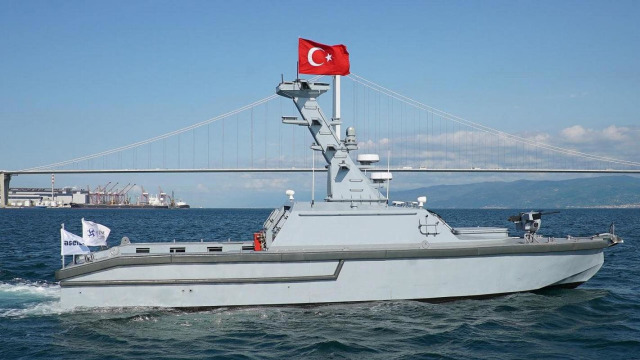The portfolio of unmanned boats (BEC) of Turkey is continuously expanding. New systems are being developed to meet the various needs of the Navy. The country has a balanced roadmap of unmanned naval programs focused on various scenarios of war at sea (for more information, see Part I ). According to sources, currently leading firms in this field agree that the future naval environment will be characterized by the need to operate in high-risk conditions with simultaneous and rapid growth of a multitude of threats.
The main projects of unmanned boats for the Turkish Navy
The Ulak Project
"Ulak" (ULAQ) is the first open project of an unmanned Turkish-made boat. In ancient Turkish culture, ulak is the title of an ambassador to the states of Central Asia, known for his knowledge, wisdom and military talents.
The Ulak project is the result of cooperation between the Ares Shipyard (Antalya) and the Meteksan Defense Defense enterprise (Ankara). According to numerous statements by Turkish Armed Forces officials, Ulak is considered by developers as a family of uninhabited surface platforms designed to solve a wide range of tasks in the interests of the Navy and other types of armed forces in the coastal zone and on the high seas.
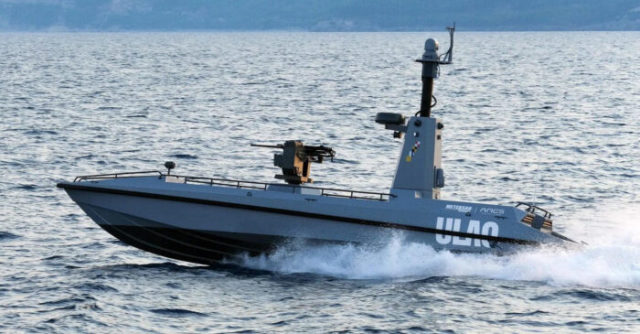
BACK ULAQ
As of the end of 2022, the well - known calendar of project activity looked like this:
- 2018-2019: research activities and substantiation of various concepts;
- 2019: exploring national capabilities and starting the prototype creation process;
- 2020: completion of the prototype design, the beginning and completion of the construction of the BEC prototype;
- October 2020: Official announcement of the project at the joint developers conference;
- February 2021: launching of the prototype and the beginning of its sea trials;
- May 2021: the first firing (at a range of 5 km) of four CIRIT missile systems and two L-UMTAS provided by the national manufacturer of missile systems Roketsan was carried out within the framework of the Sea Wolf 2021 exercise;
- August 2022: a message about the readiness for serial production of Ulak in the anti-submarine version (ASW) in the amount of up to 50 vehicles per year.
It is expected that during 2023, the Ulak BEK will enter service with the Turkish Navy.
In the collaboration of the program participants, responsibility for the design, construction and equipping of the boat is assigned to the Ares Shipyard, the integration of the payload is assigned to Meteksan Defens. The main supplier of missile weapons is Roketsan.
The prototype of the Ulak BEK launched has a hull made of modern composite materials with a length of 11 m, a displacement of 6 tons and a load capacity of up to 2 tons. The hull is equipped with passive and active stabilization systems, which allows to maintain buoyancy in case of damage.
The prototype's propulsion system (probably diesel, but the characteristics were not reported) allows for a maximum speed of up to 35 knots (65 km /h). The fuel reserve provides a cruising range of up to 400 nautical miles. It should be added that in September 2022 there were reports of an agreement between Ares Shipyard and the Turkish engine manufacturer TÜMOSAN Motor and Tractor Industry Inc. (Konya) regarding the provision of serial samples of the Ulak diesel engines of national production.
The design of the unmanned Ulak boat has a modular structure that allows configuring the payload of the device depending on the tasks to be solved. It includes an optoelectronic (day/night) surveillance system; a jam-proof global navigation satellite system; encrypted communication equipment integrated with the GENESIS and ADVENT combat control systems developed specifically for the Turkish Navy. The design of the device provides a telescopic mast, an antenna system that increases the detection and identification capabilities, a radar navigation system and monitoring of the surface situation. It also provides for the integration of high-tech advanced capabilities: artificial intelligence (AI), swarming technologies, network-centric communication and data sharing.
Depending on the tasks to be solved, Ulak will be able to carry reconnaissance and electronic warfare equipment, guided missile weapons with laser and infrared guidance, light torpedo armament or a 12.7 mm remotely controlled stabilized STAMP machine gun platform. It is believed that STAMP (manufactured by Aselsan) is particularly effective against asymmetric targets due to their automatic tracking and high probability of hitting.
The coastal control station (Turkish abbreviation SAKI), designed like the boat itself, Meteksan is created on a modular principle, which allows it to be integrated into land vehicles or Navy ships. The station is serviced by a crew consisting of a captain and a gunner. SAKI equipment includes a noise-resistant C-band data transmission channel, navigation systems and software.
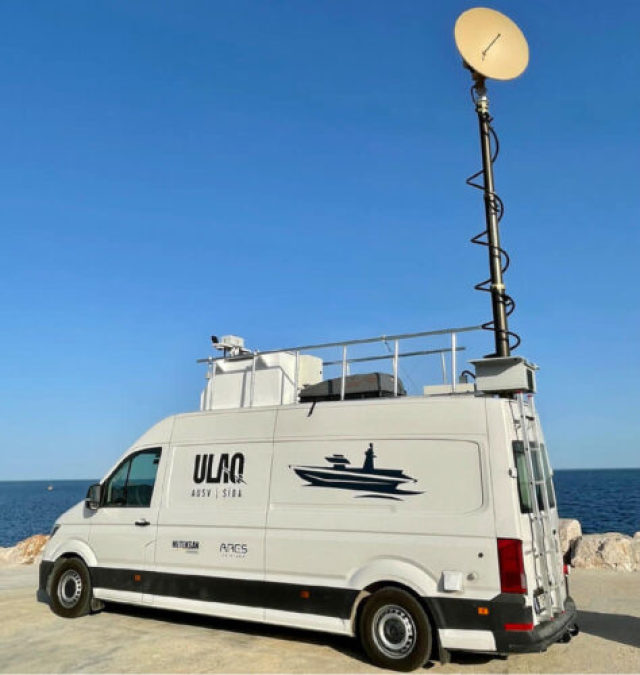
ULAQ coastal control station on a car chassis
In general, SAKI allows you to control several boats at sea and guarantees the joint operation of Ulak with other UAVs or UAVs, as well as manned aircraft at a line-of-sight distance (up to 200 km). Communication with them is organized through the KEMENT tactical data transmission channel developed by Meteksan. For control over long distances, it is possible to use retransmission through the infrastructure of the integrated communication system of the Turkish Armed Forces (Turkish Armed Forces Integrated Communication System, TAFICS).
After the development of the prototype, which became the first phase of a broader project, based on its open architecture and scalable structure, Ares Shipyard and Meteksan Defense engineers plan to create various versions of the back. According to profile publications, the Ulak family will include devices:for Port Security (PSV); reconnaissance, surveillance and Electronic warfare (ISR & EW); strike to combat surface ships (ASuW); mine defense (MCMV); fire fighting vessel (FiFi) and Anti-submarine Warfare (ASW). According to open sources, serial production of the listed variants, except for the ASW version, has not yet begun. The ready-to-manufacture version of the ASW will have increased dimensions (length slightly more than 20 m) and a load capacity of 4.5-5 tons.
Unmanned boat "Marlin"
"Marlin" is a project that is a joint development of the Sefine Shipyard (Yalova) and the Aselsan Defense Corporation (Ankara). The project is considered to be the first in the world of BACK with the capabilities of a full range of electronic warfare. The start of the block assembly of the prototype "Marlin" (under the designation RD09) was given at a ceremony held at the Sefine shipyard on July 7, 2021. The shipyard officially presented its development at the DIMDEX exhibition, in March 2022, in Doha, Qatar.
The back "Marlin" has an aluminum body with a length of 14.75 m, a width of 3.85 m and a draft of 0.85 m. Depending on the payload, the displacement ranges from 21 to 26 tons. The design of the device can be transformed from a single-body into a trimaran with outriggers (floats) attached to both sides of the body. As a result, the load capacity can increase, and floats allow you to place various types of weapons or equipment on yourself.
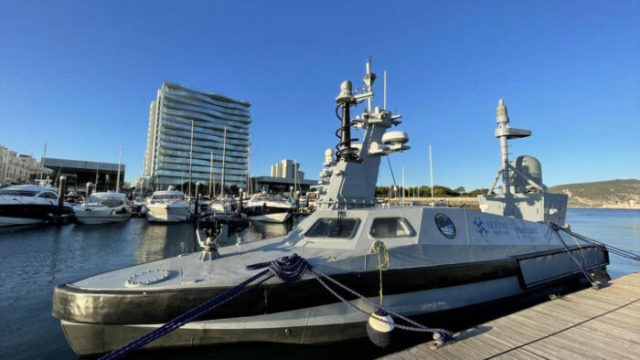
BACK MARLIN
The power plant includes two diesel engines rotating two screws in opposite directions, which, according to the manufacturer, provide high maneuverability and stability of the boat. It is claimed that the "Marlin" is capable of performing missions with sea waves up to 4 points and moving in a sea state of 5 points. The device maintains a cruising speed of 10 knots and develops a maximum speed of 36 knots. The claimed cruising range varies from 400 to 700 nautical miles at different sources. Autonomy – up to 7 days.
The payload of the device has a modular architecture and can include: an observation radar, an electron-optical reconnaissance and surveillance system, a interference-protected navigation satellite system (GNSS), communication and data transmission equipment, jettisoned and towed sonar buoys, a control system with AI elements with enhanced autonomy capabilities. The electronic warfare system installed on the device includes AREAS-2NC R-ES and AREAS-2NC R-EA products manufactured by Aselsan, providing electronic suppression and electronic support.
It is planned that the Marlin will be able to take part in offensive and defensive actions both in the coastal zone and in the open sea. In this regard, it is planned to equip the BACK with a wide range of weapons: a 12.7-mm remotely controlled weapons station, light torpedoes, guided missile systems.
In particular, in June 2022, an agreement on strategic cooperation in the field of national ammunition systems was signed between the Turkish Defense Industry Research and Development Institute (TÜBITAK SAGE) and the Sefine shipyard. As a result, there is a high probability of installing two launchers (each with 4 guides) of KUZGUN-KY surface-to-surface missiles developed by TÜBITAK SAGE on the Marlin (on floats). It is known that this modification of the rocket is equipped with a dual-mode (laser illumination and IR) homing head (GOS). The product develops a speed of up to Mach 1.5 and has a firing range of up to 40 km. It is expected that KUZGUN-KY will be tested by the first quarter of 2023 and will provide significant firepower of the boat.
BACK "Marlin" at REPMUS exercises
Turkish officials emphasize the fact that the Marlin unmanned launch has become the first Turkish unmanned naval solution that has successfully proven itself in NATO exercises. In this case, we are talking about the REPMUS events held in September 2022 off the coast of Portugal (Robotic experiments and Prototyping of Marine unmanned systems / Robotic Experiment and Prototyping with Maritime Unmanned Systems, September 12-22) and Dynamic Messenger (September 25-30).
The purpose of the exercises was to study the operation of uninhabited systems in the marine environment, their interaction with each other and with manned sea and air platforms. In total, about 1,500 civilian and military specialists from 16 NATO member countries, including Turkey, as well as about 40 uninhabited submarines, 18 uninhabited surface and about 45 UAVs, as well as 16 combat and auxiliary ships and one submarine took part in the exercises.
According to Turkish sources, the BACK "Marlin" became the only platform that went to sea on a day when no one could get out due to severe weather conditions. The complex configuration of the Marlin electronic warfare system helped the device detect the enemy at the very beginning of the exercises, which led to the movement of targets to another location. When working out the scenario of detecting enemy submarines, only "Marlin", using its sonar buoy processor, detected simulators of enemy submarines. Fulfilling the assigned tasks, the Turkish unit also demonstrated successful interaction with international manned naval units.
According to the developers, the BACK "Marlin" can go to the operational destination area independently from the port, or be delivered there by truck, air and sea transport. In this regard, the device can be considered a variant of the mission module for such types of ships of the Turkish Navy as the TCG Derya DIMDEG resupply vessel (A-1590, entering the fleet by 2025), the BAYRAKTAR tank landing ship and the TCG ANADOLU universal landing ship. It is claimed that the Marlin is successfully integrated into the combat control systems of the Turkish Navy and is able to operate autonomously or in remote control mode together with other units of the Navy.
The first prototype of the back "Marlin" in the shock version to defeat a surface enemy (ASuW) was planned to be transferred to the Turkish Navy by the end of 2022. The second prototype in the anti–submarine version (ASW) - in June 2023.
The Mir Project
MIR (MIR) is another unmanned boat jointly developed by Sefine Shipyard and Aselsan Corporation. The product under the index NB57 is designed for surface and anti-submarine warfare in heterogeneous swarms consisting of various variants of inhabited and uninhabited plateaus operating in a single compound. The first presentation of "Mir" took place in March 2022, at DIMDEX, in Doha, together with the BEC "Marlin".
Regarding the tactical and technical characteristics of the device, it is known that it has an aluminum body with a length of 15 m and a displacement of 21 tons. The design of the boat allows you to carry a payload with a total mass of 1/3 of its weight. Probably a diesel engine and a significant fuel reserve provide a range of up to 800 nautical miles (about 1500 km).
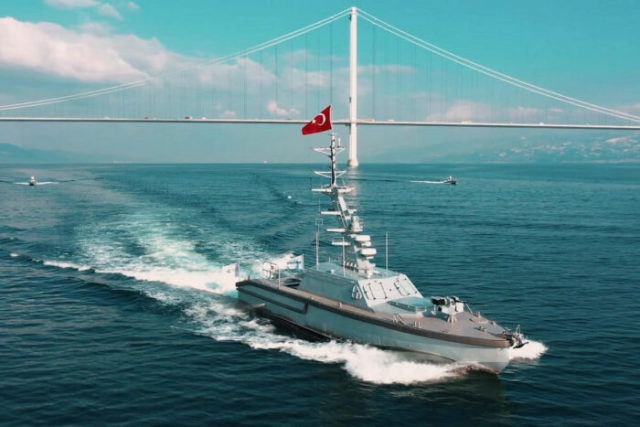
Unmanned MIR boat of the Turkish Navy
The device is designed to perform a wide range of tasks of surface, underwater and mine warfare, electronic warfare, asymmetric, reconnaissance and search and rescue operations. The Mir payload includes a set of high-tech sensors manufactured by Aselsan, namely: navigation radar, SEA EYE KIRLANGIÇ electron-optical reconnaissance and surveillance system, GNSS with KARETTA anti-interference and counterfeit equipment, ANS-510D inertial navigation system, Ku- and L-band satellite communication systems (the latter provides narrowband transmission of real-time video and images via SATCOM).
They are complemented by a 4G/LTE radio communication unit and an automatic identification system (AIS), as well as equipment for sensing the underwater sphere. It includes the ARAS-2023 submarine detection sonar, ORKUN-2053 submersible sonar, obstacle avoidance sonar, single-beam echo sounder, combat swimmer detection sonar.
Regarding the weapons complex of the BEK Mir, we are mainly talking about the installation of a 12.7-mm weapon station with a remote control STAMP-2L. Presumably, the device can be equipped with guided missiles and light torpedoes of Turkish production.
To be continued…
According to the materials of the resource edam.org.tr
